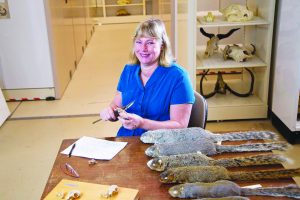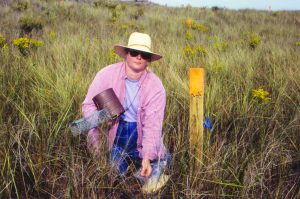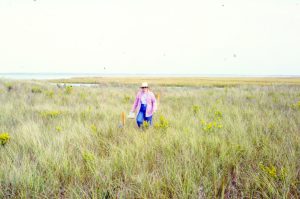After 35 years of service to the Commonwealth expanding our scientific knowledge of Virginia’s mammals, Dr. Nancy Moncrief is enjoying her retirement.
Moncrief, who had served as the Virginia Museum of Natural History’s (VMNH) Curator of Mammalogy since 1989, retired from the museum in May. The VMNH Board of Trustees voted to name Moncrief Curator Emerita at its May 18 meeting. She is one of five curators to receive the honor.
Early days

“There was no ‘a ha!’ moment in my life,” Moncrief said, regarding her decision to pursue a career studying mammals. She said that she grew up in Memphis, Tennessee with a fairly suburban upbringing, but spent a few summers in northeastern Arkansas spending time with her uncles who owned farms, riding horses and being immersed in nature.
“I was always interested in looking at differences between breeds of dogs and horses and cows and seeing subtle variations within species,” she said. “I had kind of an eye for looking for differences between individuals.”
Moncrief went to Memphis State (now the University of Memphis) for her undergraduate education. It was during a college field trip to Mexico that she realized she wanted to pursue a career in natural history.
“We went to central Mexico, which has an incredibly high diversity of bats and rodents,” she said. “I learned how to prep specimens there, and when we came back, I did more field work in the Smoky Mountains. I was doing survey work, trapping mostly mice and shrews. From there, I realized I needed to go to graduate school.”
Moncrief went on to earn her M.S. in Biology at Fort Hays State University and her Ph.D. in Zoology from Louisiana State University (LSU). At these institutions, she realized that her attention to detail made her perfectly suited for proofreading and interpreting data, a skillset that has been a constant thread throughout her career.
Another constant thread throughout her career: squirrels.
“LSU has a big squirrel collection,” Moncrief said. “That’s where I got interested in fox squirrels and gray squirrels because both of those species occur throughout the lower Mississippi River Valley. My dissertation was looking at geographic variation in fox squirrels, which is very dramatic in that region of the country … very striking color patterns and size differences in a very short east-west distance.”
Squirreled away

Moncrief has spent a large portion of her career studying squirrels, and it’s safe to say they’re her favorite animal.
However, she said, it’s not because they’re cute; it comes from an admiration for their unique skills, such as their ability to remember where they buried nuts for the winter or their ability to navigate the complex three-dimensional space of the treetops with ease.
“Their lifestyle is kind of interesting,” Moncrief said. “The real interesting thing to me is looking at coat color and size variation. What’s driving that? What caused it? What is it the result of? I’ve answered some of those questions … until someone comes along with a more precise technique than I had.”
Moncrief’s work has long been at the cutting edge of technology; for her Ph.D. dissertation in the 1980s, she used early forms of DNA analysis to compare the genetics of squirrels from different geographical regions. Within the last few years, she published a paper using much more advanced DNA sequencing to analyze the genetic reasons for coat color variations in fox squirrels and gray squirrels. This work provided the first evidence that these two species had hybridized in the past, a phenomenon called ancient introgression.
“I’m still working on squirrels using newer technology as it has become available and the price has come down,” she said. “Back in the day, I probably could have done DNA sequencing of squirrels if I’d had many millions of dollars. Waiting 20 years made it affordable.”
The Virginia Museum of Natural History
 After earning her Ph.D., Moncrief collaborated with a colleague who worked at the University of Virginia.
After earning her Ph.D., Moncrief collaborated with a colleague who worked at the University of Virginia.
“He happened to know (VMNH founder) Dr. Noel Boaz,” she said, “and he knew that Noel was establishing a natural history museum. He wrote me a good letter of recommendation, and I guess it worked,” she said with a laugh.
Boaz hired Moncrief as the VMNH Curator of Mammalogy in the fall of 1989, putting her among the first batch of curators to be hired at the museum.
When asked what has changed the most about museums over the course of her 35-year career, Moncrief said that the biggest change has been “the fact that I’m carrying around a supercomputer in my pocket.”
“Social media didn’t exist,” she said. “We had personal computers, and we had databases, but the ability to get on websites like VertNet and do searches for records of specimens in other museums … it’s so much easier now than it was.”
One useful technological advancement has been the ability to use game cameras mounted in bucket camera traps to photograph and identify mice and other rodents in the field without the need to collect live specimens.
“We can do the same level of survey work that used to be much more labor and time intensive,” she said.
However, she said, “there’s still a lot of information you get from live trapping or collecting specimens. A picture may be worth a thousand words, but for me, a picture is not worth a museum specimen. With physical evidence … we can examine it, archive it, and let somebody else come back and examine it 50 years later using their technology.”
The Barrier Islands
Throughout her career at VMNH, Moncrief spent a great deal of time conducting field work and research on Virginia’s Barrier Islands, specifically studying the population genetics of these unique environments. She said that it’s some of the work that she’s most proud of.
“Islands are natural laboratories for studying ecology and evolution because it’s a simpler system,” she said. “You don’t have as many species of predators and you don’t have as many species of prey. … Darwin worked in the Galapagos for a reason.”
During her time in the Barrier Islands, Moncrief studied rodent populations, conducted surveys of the mammal populations on the islands, and even worked to protect the rare shorebirds that nest on the islands.
“Because the islands are prime nesting habitat for endangered and threatened shorebirds, some of our colleagues who study birds wanted us to study the mammals that prey on birds, mostly raccoons,” she said. “We used our expertise in ecology and genetics to look at movement of raccoons and raccoon population dynamics. … The question is, is there something you can do to control the raccoons? Part of the answer to that is, where are the raccoons coming from?”
The islands that were the best habitats for nesting shorebirds were generally flat and lacked large vegetation, making them unsuitable for permanent raccoon populations. If the raccoons were traveling to these islands from other islands, it would be possible to control their populations. If they were coming from the mainland, however, it would be all but impossible to control them.
Moncrief and colleagues were able to determine that the raccoons were mostly coming from other nearby islands, which has allowed other colleagues to control the raccoon populations and thereby protect the endangered shorebirds.
Looking ahead
Moncrief said that now that she’s retired, she’s most excited to be able to spend more time with her husband Phil — that, and sleep in on occasion.
With more than 40 peer-reviewed publications under her belt which have been cited more than 1,800 times, you might think that Moncrief would be ready to take down her shingle. However, in what will not come as a shock to those who know her, she has no intention of completely stepping away from the scientific work that has defined her career.
“There are several projects that I started that I really want to get finished,” she said.
“And there may be new projects, too,” she added.



